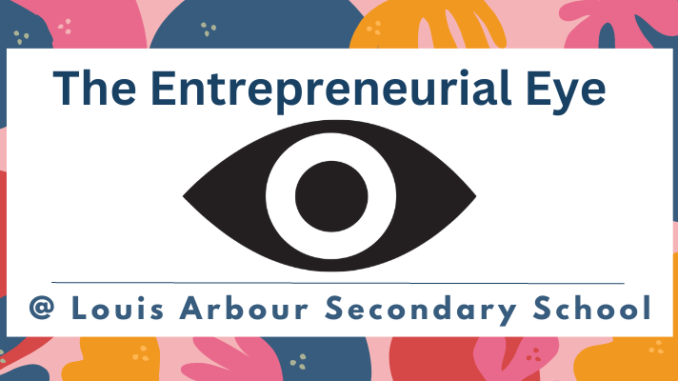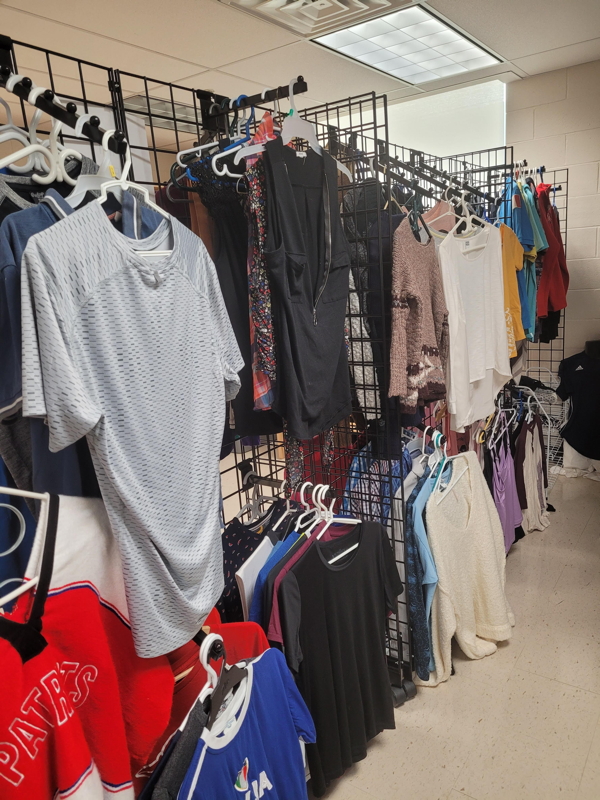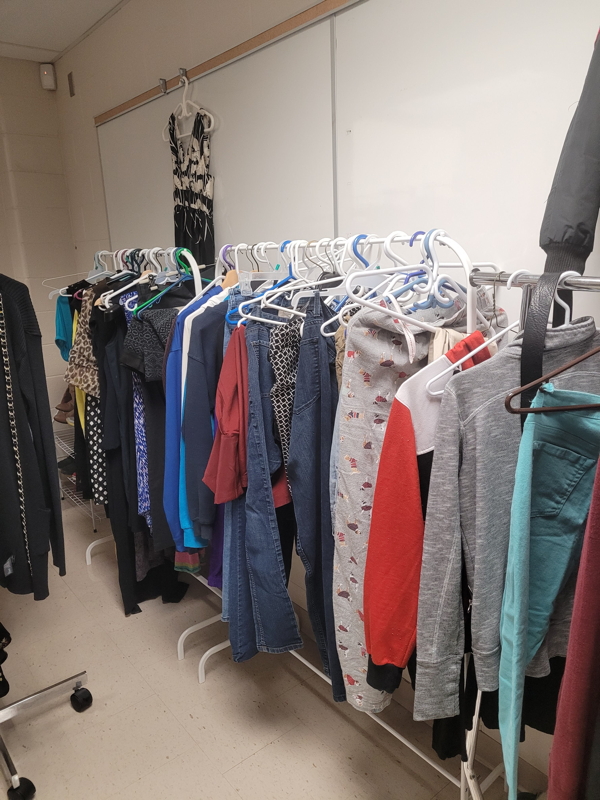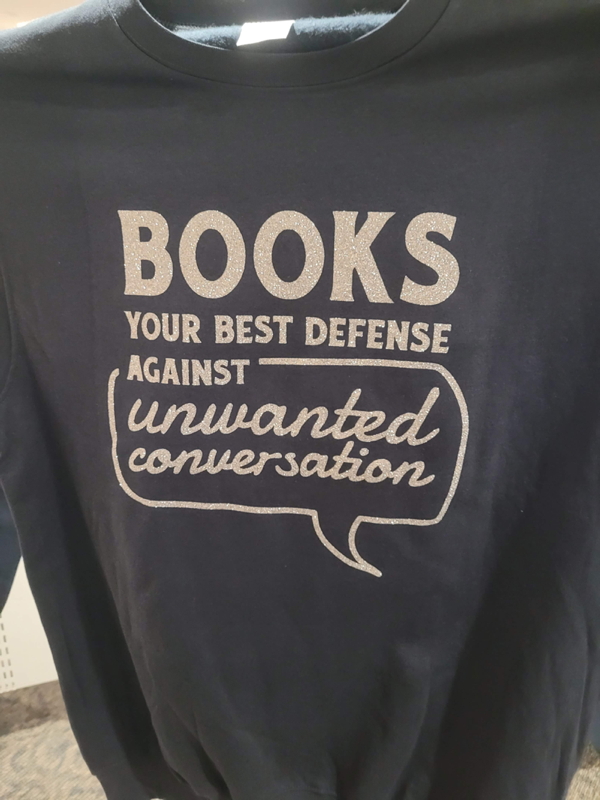
By Jonelle St. Aubyn
The inclusion of student voice is an important part of any library learning commons and finding ways of soliciting student ideas and desires can be done in many ways. At Louise Arbour Secondary School, one of the ways that we have done this has been by asking the leadership classes to share their thoughts on what we need to make the LLC more accessible and welcoming for all students. In order to also have students keep in mind the importance of equity and inclusion, we provided them with criteria to help guide their choices. One of the requests that kept coming up was the creation of a tuck shop in the library learning commons. This idea was important to them so that students would have a space to buy things at school in the event that their parents/guardians couldn’t take them to the store to get what they needed.
Although this was a great idea, having the tuck shop run by the library learning commons staff was not an ideal situation given how busy the LLC is. Also, part of our goal for the LLC was to help students develop their entrepreneurial eye and think about the possibility and potential of owning their own businesses. With this goal in mind, an idea took shape as to how we could honour the student request of having a tuck shop and provide a space for student entrepreneurs to start their own businesses and grow their entrepreneurship skills.
Wanting to involve as many relevant curricular areas as possible, I first approached the business department with the hope that they would have students who would be willing and able to manage the accounting side of the business, using their classroom experience in a real world setting. I also wanted the marketing class to be involved in making the posters and the advertisements for the shop and conduct market research to find out what students would be likely to buy in a tuck shop. Also, we wanted students to handle the social media marketing of the shop. Thankfully, three business teachers (Ms. Maxin, Ms. Dennis and Ms. Mathura) came on board without hesitation and started approaching students to take up these tasks.
Next, I approached the teachers that were in charge of running the EcoSquad (Ms. Ryan and Ms. Crupi). They had previously had an idea of having a swap shop in which students could bring in items of clothing and swap them for other items, keeping clothing out of landfill and giving them a new life. Combining the idea of the swap shop with the tuck shop sounded like a good one as it would allow students who couldn’t afford to buy anything to get what they needed for free and be ecofriendly.


Finally, I approached the Art and the Fashion teachers to help with the creation of items that could be sold in the shop. The Fashion class made scrunchies and canvas bags that could be decorated and personalized using the Cricut. The Art department had a silk-screening machine and could make designs for t-shirts or other things.
My contribution to this initiative was through teaching students how to use the Cricut to make designs for clothing so that we could sell original pieces (t-shirts, sweatshirts, hoodies, etc.) or make spirit wear in house for the various clubs and teams around the school. The LLC was also responsible for recruiting student entrepreneurs who already had items that they were creating and wanting to sell and providing a space for them to sell their creations.
Once we had a vision of what the tuck and swap shop could look like, we made a plan to present to our administration to help garner support and startup funds for the business. The plan that was presented to our administration can be found below:

Teachers at LASS from a variety of cross curricular areas brainstormed ideas on how to bring the student tuck shop to life and here is our plan of action:
- How will we decide what will be sold in the tuck shop?
We plan to use the marketing and entrepreneurship classes to do some market research through the use of surveys, via Google Forms, to find out which items students would like to purchase. QR codes would be placed around the school and in classrooms that students could click on to give us information about what they would like to buy from an in-school tuck shop.
- Where will the items that are to be sold come from?
The goal of the tuck shop is to have the majority of the items made by the students and sourced by the students. Within the school we have a number of tools that we can use to produce goods to be sold for sale. We have Cricuts, vinyl cutters, heat presses, silk screening, a 3D printer and more. Examples of items that could potentially be sold are as follows:
SHSM – Silk screening of t-shirts and cards, bumper stickers for cars, handmade cards and gifts, reusable heat sleeves for coffee cups, t-shirts, laptop stickers
Eco-Squad – Cosmetics, seedlings, smoothie prep jars filled with items needed to make a healthy, delicious smoothie at home.
Library – T-shirts, mugs, buttons
DDR – Handmade cards, trays, socks, ornaments
Business classes – Headphones and chargers
We also hope to be selling monthly themed items such as pink t-shirts and buttons for the Day of Pink.
We have the tools and materials needed to make spirit wear in house, rather than sourcing the materials from outside vendors. Students would have the benefit of learning a new skill, creating designs for the products and marketing it to the student body. School organizations (EAC, SAC, DECA, etc.) could contract items to be designed and created for the students who are a part of that organization. That would allow for more student voice and choice for students at LASS and help to increase school spirit and connection.

- Where would the items be sold?
Our ultimate goal is to get a designated classroom in which the production of goods could take place, as well as a place for items to be sold. This may take some time to get up and running so initially goods would be sold out of the LLC until we could have a permanent brick and mortar store set up in the building.
- Who would be selling the items?
All items would be sold by students under teacher supervision. Students would get volunteer hours and we would rely on different curricular areas to help us sell the goods. For example, we would have some accounting students handling the sales of the items and doing all of the accounting for the venture. Marketing and entrepreneurship students would be involved in figuring out the best way to attract customers to the store (i.e., announcements, posters, social media etc.). SHSM, Eco squad, DDR and other interested students would be involved in the production of goods. Items for sale would also be advertised to staff either in the library update or another form of communication.
- How would the money be collected?
Ideally this would be a predominantly cash business to allow for students to manage the money themselves. This would allow us to not create additional work for the budget office manager and give students the experience of handling and processing payments.
- Who would be training the students?
We have a number of education workers in the building with the knowledge and skill set to show students how to use the devices (Cricut, heat press, button maker, etc.) to produce items for sale. We would also be involved in helping them source materials to make items as well. It is our hope that we can form a partnership with the Brampton Public library to assist with the training and skill development of the students, as well as the Brampton Board of Trade and other community organizations that would be interested in working with our students.
- What is the goal of this initiative?
We want students to have hands-on experience running a business. Part of empowering modern learners is giving them the skills and knowledge that they need to be successful once they graduate and this opportunity will allow for the development of those skills and that knowledge. It gives them ownership and responsibility for what is created in the school and the autonomy to decide where they want their profits to go. It also provides an opportunity to develop their teamwork skills, communication, financial literacy, money management, creativity and more.
- What do we need to get started?
We will need funding to purchase start up materials for the items that will be sold. We hope this will be a onetime investment as the goal will be for students to be generating enough profit to purchase the materials needed to sustain production of goods on an ongoing basis. We will need access to a classroom where goods can be produced and sold and racks and storage shelves for goods to be stored. We will also need a lockable display case for students to look at the goods being sold and rack and hangers for clothing sales. A cash register or cash box would also be needed and a laptop computer for business accounting purposes.
Ultimately, we believe that this program will have enormous benefits for the students involved, the teachers, the school community and the community in which they live. It will give students an opportunity to gain skills while supporting others. The teachers that came together to generate this plan had an endless number of ideas and we know, if given the opportunity, the students will have some incredible ideas of their own. A small investment of time and money can have a lifelong impact on our students, and it is our hope that you will wholeheartedly endorse and support this incredible venture. Thank you.
Sincerely,
Ms. St. Aubyn, Ms. Crupi, Ms. Maxin, Ms. Dennis, Ms. Kraska and Ms. Saini

Our principal was extremely enthusiastic about the potential of the tuck and swap shop, and we were able to secure financial support to help us buy the things that we needed to get started with the ultimate goal of becoming a self-sufficient business. All profits generated from the sale of student entrepreneurs would go directly to them and any things sold by organizations within the school would go back to supporting those organizations such as the EcoSquad and the REACH program. Profits made by things created in the LLC would be used toward keeping the business afloat and any other charities that we wanted to support.
In our grand opening we started by selling handmade environmentally friendly bath and cosmetic products created by our EcoSquad. We had a number of student entrepreneurs who were selling necklaces, bracelets, waist beads, anklets, key chains, bookmarks and more. We took orders for custom spirit wear using a link that we had created and sold readymade clothing as well. Instead of swapping items on the swap shop side, students were free to take whatever they wanted for free! Staff and students were excited that this was coming to fruition! The shop was open every Tuesday and Friday from 11:30 am until 12:30 pm and students that volunteered in the shop received volunteer hours.
Our initial location was not ideal. We were at the furthest end of the school in a back corner of the building. This heavily impacted our foot traffic and although we were selling some items, sales were not as high as we had been hoping. Even with posters and announcements, we were not reaching as many students as we would have liked. Despite the less than ideal location, we were able to make close to $700 in profits, thanks heavily in part to the sale of spirit wear and each organization garnering additional funds for their own projects.
We are now in the second year of the business, and we were able to secure a new location in the second year of the tuck and swap shop right in the main hallway of the school. This greatly increased sales and traffic of students in and out of the shop. This year we made the sweatshirt designs for the SAC (student activity council) and raised just over $700 in support of Regeneration (a local food bank and thrift shop in Brampton). We have added new products to our sales offerings such as sprouting kits and, warm and fresh cookies sold by our hospitality department. We have gone from selling about twenty-four cookies in our initial opening to now having a line up and selling over fifty cookies! Despite achieving a measure of success this year, we had to reduce our shop hours from two days to one, only opening on Fridays, as having staff supervision became challenging due to the busy schedules of the educators involved.
The LASS Tuck and Swap shop continues to evolve and grow. Ideally our goal is to have more guest presentations where students can learn to create their own products from those who are already experiencing success as an entrepreneur in their own right. With the popularity of the cookies, we hope to provide more food items as well. We are always brainstorming new ideas about how to move the Tuck and Swap shop forward. It’s amazing that a student idea has blossomed into this wonderful initiative.
Follow the LASS Tuck and Swap Shop on Instagram

Jonelle St. Aubyn is a teacher-librarian at Louise Arbour Secondary School in the Peel District School Board, Ontario. She has been teaching for 22 years with the last 8 being in the library learning commons. Passionate about social justice, equity and human rights, Jonelle has been curating resources for staff, students and community members to move this work forward at Louise Arbour Secondary School and beyond. Jonelle was one of the team members that revised the Teacher-Librarianship Additional Qualification course guidelines for the Ontario College of Teachers. She is also a recipient of the OSSTF District 19 Inspiring Moments Campaign and the Teachers Life Exceptional Educator Award. Most recently, Jonelle was a 2022 recipient of the Canadian School Libraries Angela Thacker Memorial Award for her outstanding contributions to teacher-librarianship.